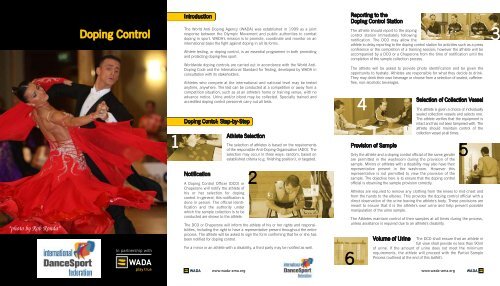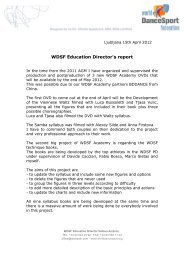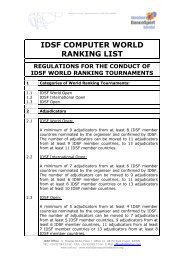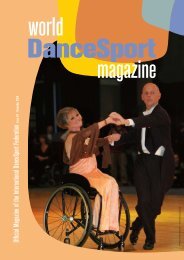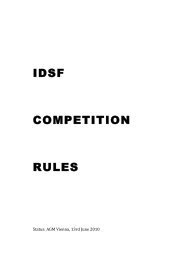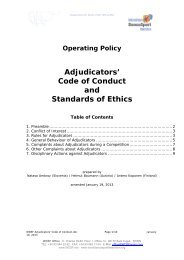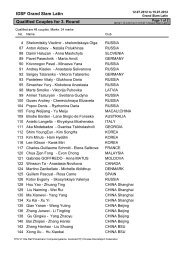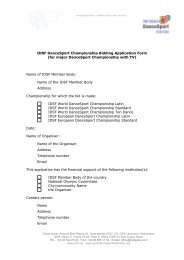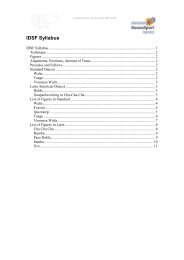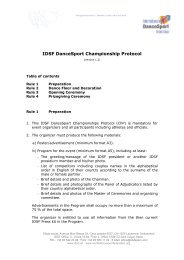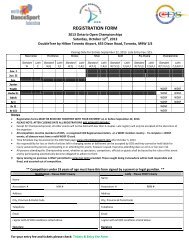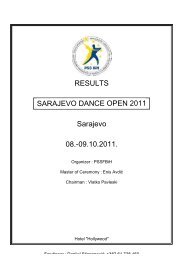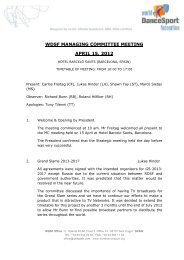Anti Doping Flyer - World DanceSport Federation
Anti Doping Flyer - World DanceSport Federation
Anti Doping Flyer - World DanceSport Federation
Create successful ePaper yourself
Turn your PDF publications into a flip-book with our unique Google optimized e-Paper software.
”photo by Rob Ronda”<br />
Votre logo ici<br />
<strong>Doping</strong> Control<br />
1<br />
Introduction<br />
The <strong>World</strong> <strong>Anti</strong>-<strong>Doping</strong> Agency (WADA) was established in 1999 as a joint<br />
response between the Olympic Movement and public authorities to combat<br />
doping in sport. WADA's mission is to promote, coordinate and monitor on an<br />
international basis the fight against doping in all its forms.<br />
Athlete testing, or doping control, is an essential programme in both promoting<br />
and protecting doping-free sport.<br />
<strong>World</strong>wide doping controls are carried out in accordance with the <strong>World</strong> <strong>Anti</strong>-<br />
<strong>Doping</strong> Code and the International Standard for Testing, developed by WADA in<br />
consultation with its stakeholders.<br />
Athletes who compete at the international and national level may be tested<br />
anytime, anywhere. The test can be conducted at a competition or away from a<br />
competition situation, such as at an athlete's home or training venue, with no<br />
advance notice. Urine and/or blood may be collected. Specially trained and<br />
accredited doping control personnel carry out all tests.<br />
<strong>Doping</strong> Contol: Step-by-Step<br />
Notification<br />
A <strong>Doping</strong> Control Officer (DCO) or<br />
Chaperone will notify the athlete of<br />
his or her selection for doping<br />
control. In general, this notification is<br />
done in person. The official identification<br />
and the authority under<br />
which the sample collection is to be<br />
conducted are shown to the athlete.<br />
Athlete Selection<br />
The selection of athletes is based on the requirements<br />
of the responsible <strong>Anti</strong>-<strong>Doping</strong> Organisation (ADO). The<br />
selection may occur in three ways: random, based on<br />
established criteria (e.g. finishing position), or targeted.<br />
2<br />
The DCO or Chaperone will inform the athlete of his or her rights and responsibilities,<br />
including the right to have a representative present throughout the entire<br />
process. The athlete will be asked to sign the form confirming that he or she has<br />
been notified for doping control.<br />
For a minor or an athlete with a disability, a third party may be notified as well.<br />
Reporting to the<br />
<strong>Doping</strong> Control Station<br />
The athlete should report to the doping<br />
control station immediately following<br />
notification. The DCO may allow the<br />
athlete to delay reporting to the doping control station for activities such as a press<br />
conference or the completion of a training session; however the athlete will be<br />
accompanied by a DCO or a Chaperone from the time of notification until the<br />
completion of the sample collection process.<br />
The athlete will be asked to provide photo identification and be given the<br />
opportunity to hydrate. Athletes are responsible for what they decide to drink.<br />
They may drink their own beverage or choose from a selection of sealed, caffeinefree,<br />
non-alcoholic beverages.<br />
4<br />
Provision of Sample<br />
Selection of Collection Vessel<br />
The athlete is given a choice of individually<br />
sealed collection vessels and selects one.<br />
The athlete verifies that the equipment is<br />
intact and has not been tampered with. The<br />
athlete should maintain control of the<br />
collection vessel at all times.<br />
Only the athlete and a doping control official of the same gender<br />
are permitted in the washroom during the provision of the<br />
sample. Minors or athletes with a disability may also have their<br />
representative present in the washroom. However this<br />
representative is not permitted to view the provision of the<br />
sample. The objective here is to ensure that the doping control<br />
official is observing the sample provision correctly.<br />
Athletes are required to remove any clothing from the knees to mid-chest and<br />
from the hands to the elbows. This provides the doping control official with a<br />
direct observation of the urine leaving the athlete's body. These provisions are<br />
meant to ensure that it is the athlete's own urine and help prevent possible<br />
manipulation of the urine sample.<br />
The Athletes maintain control of their samples at all times during the process,<br />
unless assistance is required due to an athlete's disability.<br />
6<br />
Volume of Urine<br />
5<br />
The DCO shall ensure that an athlete in<br />
full view shall provide no less than 90ml<br />
of urine. If the amount of urine does not meet the minimum<br />
requirements, the athlete will proceed with the Partial Sample<br />
Process (outlined at the end of this leaflet).<br />
3<br />
www.wada-ama.org<br />
www.wada-ama.org
7<br />
Splitting the Sample<br />
If the athlete has provided the required volume of urine,<br />
the athlete will be given a choice of individually sealed<br />
sample collection kits, from which to choose one. The<br />
athlete verifies that the equipment is intact and has not<br />
been tampered with. The athlete will open the kit and<br />
confirm that the sample code numbers on the bottles, the<br />
lids and the container all match.<br />
The athlete splits the sample, pouring the urine<br />
him or herself, unless assistance is required due<br />
to an athlete's disability.<br />
Selection of the Sample Collection Kit<br />
The athlete pours the required volume of urine<br />
into the "B" bottle. Then the remaining urine is<br />
poured into the "A" bottle. The athlete will be<br />
asked to leave a small amount of urine in the<br />
collection vessel so the <strong>Doping</strong> Control Officer can measure the specific gravity of<br />
the sample according to the relevant laboratory guidelines.<br />
9<br />
Measuring Specific Gravity<br />
The DCO measures the specific gravity using the<br />
residual urine left in the collection vessel. The values<br />
are recorded on the doping control form. If the sample<br />
does not meet the specific gravity requirements, the<br />
athlete may be asked to provide additional samples as<br />
required by the <strong>Anti</strong>-<strong>Doping</strong> Organization.<br />
Sealing the Samples<br />
The athlete seals the "A" and "B" bottles.<br />
The athlete representative and the doping<br />
control officer should verify that the bottles<br />
are sealed properly.<br />
10<br />
8<br />
12<br />
Completion of <strong>Doping</strong> Control Form<br />
The athlete is asked to provide information about<br />
any prescription/non-prescription medications or<br />
supplements he or she has taken recently. These<br />
medications are recorded on the doping control<br />
form. The athlete has the right to note comments<br />
and concerns regarding the conduct of the doping<br />
control session. The athlete should confirm that all<br />
of the information on the doping control form is<br />
correct, including the sample code number.<br />
The person who witnessed the passing of the sample, the athlete representative,<br />
the <strong>Doping</strong> Control Officer and the athlete will sign the doping control form at the<br />
end of the sample collection process.<br />
The athlete is given a copy of the doping control form.<br />
11<br />
The laboratory copy of the doping control form does not contain any information<br />
that could identify the athlete.<br />
The Laboratory Process<br />
Samples are packaged for shipping to<br />
ensure that the security of the sample is<br />
tracked. The samples are sent to a<br />
WADA-accredited laboratory. The<br />
laboratory will inspect the samples upon<br />
their arrival to ensure there is no<br />
evidence of tampering.<br />
The WADA-accredited laboratory will adhere to the International Standard for<br />
Laboratories when processing a sample, ensuring the chain of custody is<br />
maintained at all times.<br />
The "A" sample will be analyzed for substances on the Prohibited List. The "B"<br />
sample is securely stored at the laboratory and may be used to confirm an<br />
Adverse Analytical Finding from the "A" sample.<br />
The laboratory will report the results of the sample analysis to the responsible<br />
<strong>Anti</strong>-<strong>Doping</strong> Organization and WADA.<br />
Partial Sample Process<br />
Combining the Sample<br />
Sealing the Partial Sample<br />
When less than 90ml of urine is provided, the<br />
athlete will proceed with the partial sample<br />
process until the required amount of volume is<br />
provided. During this process the partial<br />
sample(s) will be sealed and secured using the<br />
partial sample equipment.<br />
The sealed partial sample should remain in the<br />
control of either the athlete or the DCO. While<br />
waiting to provide additional sample(s), the<br />
athlete shall remain under continuous observation and be given the opportunity to<br />
hydrate. When the athlete is ready to provide another sample, the process of<br />
sample collection continues as described before.<br />
When the required amount of urine has been provided, the athlete will select a<br />
new, sealed collection vessel and combine his or her samples, beginning with the<br />
first partial sample provided and each subsequent partial sample until the<br />
desired volume is reached. The sample is then sealed according to the steps<br />
outlined before.<br />
1 2 3<br />
Final Notes<br />
The information and the materials shown in this booklet are meant to serve as a<br />
guide to the urine sample collection process; it does not reflect an opinion on the<br />
type of equipment to be used.<br />
Testing worldwide should follow the principles of these guidelines, although there<br />
may be slight variations in the procedures adopted by different anti-doping<br />
organizations, which will not affect the integrity of the process.<br />
For further information, please contact your National <strong>Anti</strong>-<strong>Doping</strong> Organization, or<br />
International or National <strong>Federation</strong>. You may also visit our Web site at<br />
www.wada-ama.org.<br />
www.wada-ama.org<br />
www.wada-ama.org<br />
www.wada-ama.org<br />
The International <strong>DanceSport</strong><br />
<strong>Federation</strong> in cooperation<br />
with WADA<br />
Produced in collaboration with the<br />
Swiss Federal Office of Sport,<br />
Magglingen (Switzerland)


